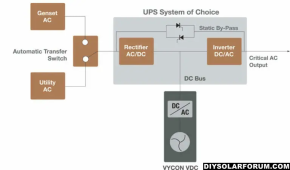hwy17
Anti-Solar Enthusiast
I have quite a reverence for the grid as being a kinetic system, and the beauty of the way that spinning generators both impart and absorb energy from the grid innately, not at the speed of a microprocessor's control but in a pure and true analog way.
I have wondered before if there would be any way to apply a small scale synchronous condenser to an off grid system, a rotating mass that would absorb very little power to keep it in rotation and be ready to impart significant power to a short circuit or inductive load.

 en.wikipedia.org
en.wikipedia.org
Anyone have any thoughts on the idea?
The first hurdle is definitely 3 phase vs single phase. I don't have the advanced EE knowledge to know if a single phase synchronous condenser can even be helpful or if the imbalance of the power flow would just make the rotor fight the sine wave in 4 different ways through the revolution clock.
That's where I've got stuck. If they only work on 3 phase then I would first need to build a 3 phase off grid system which is possible but expensive. Then perhaps any quality 3 phase synchronous motor with a rotating mass could help.
If they can help on a single phase system, then there are some details to iron out about what motors will work. My pool pump motor is synchronous single phase, but it supposedly runs at 3450 not 3600 due to some kind of phase angle drift that's slightly beyond my understanding. If allowed to run in freewheel would it come up to a full 3600? Maybe. Can it provide reactive power back through its capacitive supply? I don't know. Perhaps permanent magnet rotors are required or beneficial.
I have wondered before if there would be any way to apply a small scale synchronous condenser to an off grid system, a rotating mass that would absorb very little power to keep it in rotation and be ready to impart significant power to a short circuit or inductive load.

Synchronous condenser - Wikipedia
Anyone have any thoughts on the idea?
The first hurdle is definitely 3 phase vs single phase. I don't have the advanced EE knowledge to know if a single phase synchronous condenser can even be helpful or if the imbalance of the power flow would just make the rotor fight the sine wave in 4 different ways through the revolution clock.
That's where I've got stuck. If they only work on 3 phase then I would first need to build a 3 phase off grid system which is possible but expensive. Then perhaps any quality 3 phase synchronous motor with a rotating mass could help.
If they can help on a single phase system, then there are some details to iron out about what motors will work. My pool pump motor is synchronous single phase, but it supposedly runs at 3450 not 3600 due to some kind of phase angle drift that's slightly beyond my understanding. If allowed to run in freewheel would it come up to a full 3600? Maybe. Can it provide reactive power back through its capacitive supply? I don't know. Perhaps permanent magnet rotors are required or beneficial.






